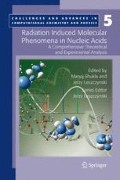Abstract
The relativistic complete active-space second-order perturbation theory (CASPT2) developed for the four-component relativistic Hamiltonian is introduced in this chapter. This method can describe the near-degenerated and dissociated electronic states of molecules involving heavy elements. This method is applicable for the systems which can be described by neither DFT nor single reference methods, and the system with very heavy-elements which cannot be described by quasi-relativistic approaches. The present theory provides accurate descriptions of bonding or dissociation states and of ground and excited states in a well-balanced way. In this review, for example, the ground and low-lying excited states of diatomic molecules with 6p series, TlH, Tl2, PbH, and Pb2 are calculated with the Dirac–Coulomb (DC) CASPT2 method and their spectroscopic constants and potential energy curves are presented. The obtained spectroscopic constants are compared with experimental findings and previous theoretical works. For all the molecules, the spectroscopic constants of DC-CASPT2 show reasonably good agreement with the experimental or previous theoretical spectroscopic constants
Access this chapter
Tax calculation will be finalised at checkout
Purchases are for personal use only
Preview
Unable to display preview. Download preview PDF.
References
REL4D: Abe M, Iikura H, Kamiya M, Nakajima T, Yanagisawa S, Yanai T.
Yanai T, Kamiya M, Kawashima Y, Nakajima T, Nakano H, Nakao Y, Sekino H, Paulovic J, Tsuneda T, Yanagisawa S, Hirao K (2004) The UTChem program package is available on http://utchem.qcl.t.u-tokyo.ac.jp/
Visscher L, Visser O, Aerts H, Merenga H, and Nieuwpoort WC (1994) Comput Phys Commun 81: 120.
Saue T, Fægri K, Jr, Helgaker T, and Gropen O (1997) Mol Phys 91: 937.
Yanai T, Nakajima T, Ishikawa Y, and Hirao K (2001) J Chem Phys 114: 6526.
Abe M, Yanai T, Nakajima T, and Hirao K (2004) Chem Phys Lett 388: 68.
Visscher L, Eliav E, and Kaldor U (2001) J Chem Phys 115: 9720.
Fleig T, Jensen HJA, Olsen J, and Visscher L (2006) J Chem Phys 124: 104106.
Miyajima M, Watanabe Y, and Nakano H (2006) J Chem Phys 124: 044101.
Abe M, Nakajima T, and Hirao K (2006) J Chem Phys 125: 234110.
Andersson K, Malmqvist PÅ, Roos BO, Sadlej AJ, and Woliñski K (1990) J Phys Chem 94: 5483.
Andersson K, Malmqvist PÅ, and Roos BO (1992) J Chem Phys 96: 1218.
Seth M, Schwerdtfeger P, and Fægri K (1999) J Chem Phys 111: 6422.
Fægri K and Visscher L (2005) Theor Chem Acc 105:265.
Rakowitz F and Marian CM (1997) Chem Phys 225: 223.
Hess BA and Maran CM (2000) In: Jensen P and Bunker PR (ed) Computational Molecular Spectroscopy, Wiley, Sussex, p. 169.
Kim MC, Lee HS, Lee YS, and Lee SY (1998) J Chem Phys 109: 9384.
Han YK and Hirao K (2000) J Chem Phys 112: 9353.
Roos BO and Malmqvist PÅ (2004) Phys Chem Chem Phys 6: 2919.
Christiansen PA (1983) J Chem Phys 79: 2928.
Christiansen PA and Pitzer KS (1981) J Chem Phys 74: 1162.
Vijayakumar M and Balasubramanian K (1992) J Chem Phys 97: 7474.
Isaev TA, Mosyagin NS, Titov AV, Alekseyev AB, and Buenker RJ (2002) Int J Quantum Chem 88: 687.
Mayer M, Kruger S, and Rosch N (2001) J Chem Phys 115:4411.
Huzinaga S and Arnau C (1970) Phys Rev A 1: 1285.
Potts DM, Taylor CM, Chaudhuri RK, and Freed KF (2001) J Chem Phys 114: 2592.
Tsuchiya T, Abe M, Nakajima T, and Hirao K (2001) J Chem Phys 115: 4463.
Nakajima T and Hirao K (2000) J Chem Phys 113: 7786.
Koc K and Ishikawa Y (1994) Phys Rev A 49: 794.
Faegri K (2001) Theo Chem Acc 105: 252.
Huber KP and Hertzberg G (1979) In: Molecular Spectra and Molecular Structure. IV. Constants of diatomic molecules, van Nostrand Reinhold, New York.
Ginter ML and Battino R (1965) J Chem Phys 42: 3222.
Froben FW, Schulze W, and Kloss U (1983) Chem Phys Lett 99:500.
Hertzberg (1950) In: Molecular spectra and Molecular structure. I. Spectra of Diatomic Molecules, Van Nostrand Reinhold, New York.
Wood D and Andrew KL (1968) J Opt Soc Am 58: 818.
Frohen F, Schulze W, and Kloss U (1983) Chem Phys Letters 99: 500.
Sonntag H and Weber R (1983) J Mol Spectrosc 100: 75.
Author information
Authors and Affiliations
Editor information
Editors and Affiliations
Rights and permissions
Copyright information
© 2008 Springer Science+Business Media B.V.
About this chapter
Cite this chapter
Abe, M., Gopakmar, G., Nakajima, T., Hirao, K. (2008). Relativistic Multireference Perturbation Theory: Complete Active-Space Second-Order Perturbation Theory (CASPT2) With The Four-Component Dirac Hamiltonian. In: Shukla, M.K., Leszczynski, J. (eds) Radiation Induced Molecular Phenomena in Nucleic Acids. Challenges and Advances In Computational Chemistry and Physics, vol 5. Springer, Dordrecht. https://doi.org/10.1007/978-1-4020-8184-2_6
Download citation
DOI: https://doi.org/10.1007/978-1-4020-8184-2_6
Publisher Name: Springer, Dordrecht
Print ISBN: 978-1-4020-8183-5
Online ISBN: 978-1-4020-8184-2
eBook Packages: Chemistry and Materials ScienceChemistry and Material Science (R0)

